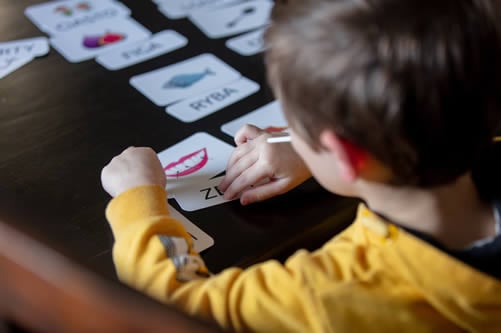You can’t cure autism but there are lots of strategies and therapies out there that can help build a child’s confidence and social understanding to give them the best chance of having a meaningful and happy life. Not all of them will suit all families so it’s mostly a matter of giving things a try to see what works for your child.
But one approach which seems to arouse particularly strong feelings, both for and against it, is ABA – Applied Behavioural Analysis. It is a branch of psychology that developed in the USA in the 1960s and is based on scientific research into the way humans learn new skills and behaviours. Today it’s widely used with autistic children in the UK as it is said to be an effective way of decreasing challenging behaviour and introducing new, more positive ways of interacting.
Although it’s a complex subject, in simple terms, it involves setting goals for new behaviour and breaking these into smaller, ‘doable’ steps, which are repeated again and again. The youngster is rewarded when they do the ‘right’ thing – for example, with a token, praise, a biscuit, playing with a favourite toy or a visit to the park – though it can be anything the person values. The theory is that this will encourage them to repeat the desired behaviour. Experts say it can be used for anything from decreasing episodes of self-harm to toilet training and developing communication.
Controversial History

Many parents swear that ABA has greatly improved their autistic child’s behaviour and life skills. However, just as many people – including families, teachers, health professionals and neurodiverse people themselves – are adamant that this approach is inhumane and doesn’t allow people with ASD the freedom to be themselves.
One small research study in the USA in 2018 looked at the prevalence of PTSD (post-traumatic stress disorder) in autistic people who had experience of ABA in early childhood. It found that almost half the people taking part met the threshold for a diagnosis of PTSD.
Magda studied autism in children for her master’s degree and has worked with youngsters with special needs for more than twenty years. “When ABA started out in the 1960s, it was pretty drastic – children were punished for not doing the right thing,” she explains. “Things have changed and they don’t do that any more but it’s still not my type of teaching. We have to respect different opinions and I know some people think it’s great, but personally, I’m not a fan of training a child like a circus animal.
Repressing Instincts

“Take eye contact,” she continues. “It’s a massive issue for people with autism but some ABA practitioners claim that you can train them to hold someone’s gaze for five seconds. That’s a really long time and most neurotypical people would find it difficult!”
In a similar way, Magda says, she has seen teachers use ABA techniques to try and stop children from stimming. This, she maintains, is cruel as it squashes their natural coping mechanisms. “Stimming means a lot to autistic people. It’s a way of regulating themselves and dispelling excess energy and anxiety,” she points out. “Some research suggests that if people suppress who they are, it can actually lead to challenging behaviour.”
In addition, she says, making a child repeat an action over and over – especially youngsters with verbal ability – robs them of their dignity.
Robotic Learning

Joanna, director of SENsational Tutors, is a qualified teacher with a master’s degree in SEN. She concedes that ABA may sometimes be useful in exceptional circumstances – for example, where a child needs to be kept safe. “If a child is feeling anxious or overwhelmed, it may be useful for them to have internalised an automated response. This could be a calming technique or specific method of communication which may reduce any risks,” she elaborates. “For example, the child may have been coached through ABA to hold tightly onto a sensory toy for sensory feedback instead of running into the road in a heightened state.”
But overall, she feels strongly that ABA diminishes a student’s love of learning for its own sake. She recalls how, some years ago, she worked one-to-one with a student who attended a specialist ABA school during the day. “His parents wanted me to help with his language and speech,” she says. “I tutored him for several months and by the end, he was speaking in full sentences. I used visual aids, without any rewards, and he made progress simply because he liked being with me. For me, developing a natural relationship is key.”
“One day, I had to go into his school,” she carries on, “and I had the experience of seeing him in that environment. It was heartbreaking – he was completely passive and unstimulated. He was like a different person.”
Repeating Is Not The Same As Understanding

Another criticism of ABA is that it teaches autistic kids to act in a socially-acceptable way without necessarily understanding the emotional reasons behind what they’re doing – essentially masking.
“I remember one child who’d been trained to go up to people when they first met them, look them in the eye and say, ‘What is your name?’” Magda explains. “The child did this but never waited for an answer because they didn’t know why they were doing it. If you’re consistent, kids will learn certain behaviours but they aren’t meaningful.”
Joanna concurs. “I recently spoke to one dad who has a four-year-old daughter with autism and developmental delay,” she comments. “They’d tried ABA sessions with the child for a few weeks but gave up because they found the results ‘weird and freaky’. The girl was coming out with the responses she’d learned but she sounded robotic, they said. Her parents also felt she’d become innately sad in the process. The dad said he couldn’t bear to imagine her at the age of ten having learned years of masking.”
Parents Are Desperate

Part of the problem, both agree, is that families can struggle to accept their child’s autism diagnosis and are desperate to find ways to help their son or daughter appear ‘normal’ and ‘fit in’ to society. This makes them vulnerable to any intervention that seems to promise a cure for certain aspects of ASD. And because the general idea of ABA is that a child needs at least twenty hours per week in order for it to be effective, it can be hugely expensive.
Building a positive teacher-student relationship and finding ways to make lessons interesting and fun, is so much more effective at helping children to develop into well-rounded individuals, Joanna comments, than using mindless repetition. “There are so many different things you can do. In one study, for example, researchers put exercise equipment in the classroom and children did their lessons while on the running machine. They learned better than when they were sitting still!”
Magda concludes that the neurotypical world needs to be more accepting of autistic people and their quirks. “In my opinion, we shouldn’t be trying to change people’s personalities. People with autism are wired a bit differently but they are all their own person and we should respect that. If a child is not doing any harm to themselves or their surroundings, why stop their behaviour?”
The National Autistic Society’s Stance
Charity the National Autistic Society has the following statement on their website –
‘Some early forms of ABA were barbaric, including even the use of electric shocks. We would never, ever allow anything like this to be used in the UK today. People are rightly concerned and angry that such interventions were ever used: we are too, and we call them out if we see them.
ABA is now one of the most researched of all autism approaches, but there are significant limitations and gaps in the research, particularly regarding long-term effects.
People’s views about ABA are strongly polarised. Some point out that ABA has developed considerably, can help people develop vital life skills and help them stay safe. Others fundamentally opposed and reported being traumatised by its use. It is also clear that there is significant variation in the quality of training, practice and formal guidance. As with any support, these things are vital.
We do not support any intervention that follows one-size-fits-all approaches…….and we believe that some ABA interventions used today are not sufficiently person-centered and are too intensive.’




